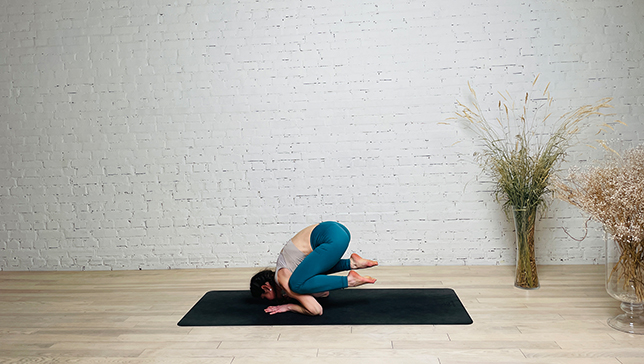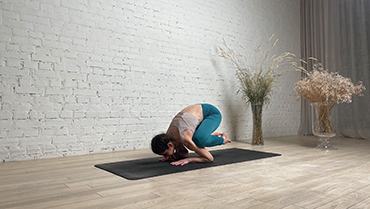Baby Crow Pose - Bala Bakasana

Contents
Baby Crow Pose or Bala Bakasana in Sanskrit (Bala means ‘baby’, Baka means ‘crow’, and Asana means ‘pose’) is a cross between Crow Pose (Bakasana) and Duck Pose (Karandavasana).
Baby Crow Pose is an advanced-level pose that serves as a preparatory pose for Feathered Peacock Pose (Pincha Mayurasana). Here the body is balanced on the forearms which makes this arm balancing pose variation unique and interesting to build the required strength and balance for other arm balance poses.
Baby Crow Pose tones the core, strengthens the shoulders and arms, creates a stretch through the upper back, and helps build balance and focus.
This also avoids putting the whole weight on the wrists, hence the pose is especially good for those who have issues with their wrists!
Also known as: Duck Pose or Karandavasana, Bala Kakasana
Pose Detail
- Difficulty: Advanced
- Body Position: Arm & Leg Support, Inversion Yoga Poses
- By Type: Arm Balance Yoga Poses, Balancing Yoga Poses, Strengthening Yoga Poses
- By Benefit: Yoga Poses For Stress Relief, Yoga Poses For Weight Loss
Step-by-Step Instructions
Benefits and Contraindications
Improves balance and focus
Strengthens your wrists and arms
Tones all organs in the abdomen.
Knee, back or neck injuries
High blood pressure
Hernia or abdominal pain
Pregnancy
Photo poses in different angles

Modifications and Props for Beginners
- Try placing a block underneath your feet. This enables you to bring your shins higher on your upper arms, even if you have tight hips; this increases the likelihood of you getting into the pose. Engage your ab muscles as you lift one leg. Lower that leg and lift your other leg. Work toward lifting both feet at the same time.
- Looping a strap around your upper arms can help keep your elbows at shoulder distance apart and can encourage the action of energetically drawing in toward the midline.
Technical Clues
- Squeeze the knees into your upper arms.
- Squeeze your elbows in like you would in a Low Plank (Chaturanga Dandasana), staying very active in your arms and not letting your elbows come beyond parallel.
Think heels to butt, and really lift up through the legs. - Draw your abdominal wall in and up to help support the weight of the body in the arm balance.
- Shift your more weight forward than you think is necessary, and feel the weight in forearms, palms, and fingertips.
- Envision the whole body engaging and lifting up. Nothing should be loose or disengaged here.
Baby Crow Pose or Bala Kakasana is deceptively harder than crow pose because your center of gravity is so close to the floor. This pose will build your shoulder and core strength.
Variations
- Crow Pose
- Flying Crow Pose
- Crow Pose With A Block
- Crow Pose With A Chair